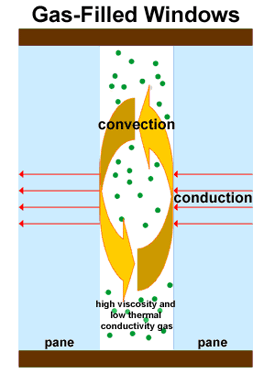Types of Glazing Continued: Multiple Layered Assemblies
The third type of modern window glazing is multiple-layered assemblies with or without either of the first two items.
Gas Fills
Filling the space with a less conductive, more viscous, or slow-moving gas minimizes the convection currents within the space, conduction through the gas is reduced, and the overall transfer of heat between the inside and outside is reduced.
Argon and Krypton gases with measurable improvement in thermal performance have been used. A mixture of krypton and argon gases is also used as a compromise between thermal performance and cost. The table below compares the two gasses.
| - | Argon | Krypton |
|---|---|---|
| Cost | Inexpensive | More expensive |
| Miscellaneous | Nontoxic, nonreactive, clear and odorless | - |
Xenon gas may also be used and provides R-20 per inch.
Layers of Glass and Air Spaces
Layers of Glass and Air Spaces may be either single-pane, double-pane, triple-pane or multi-pane.
- Standard single-pane glass has very little insulating value (approximately R-1). It provides only a thin barrier to the outside and can account for considerable heat loss and gain. Traditionally, the approach to improve a window's energy efficiency has been to increase the number of glass panes in the unit, because multiple layers of glass increase the window's ability to resist heat flow.
- Double-pane or triple-pane windows have insulating air-filled or gas-filled spaces between each pane. Each layer of glass and the air spaces resist heat flow. The width of the air spaces between the panes is important, because air spaces that are too wide (more than 5/8 inch) or too narrow (less than 1/2 inch) have lower R-values (i.e., they allow too much heat transfer).
- Advanced, multi-pane windows are now manufactured with inert gases (argon or krypton) in the spaces between the panes because these gases transfer less heat than does air. Multi-pane windows are considerably more expensive than single-pane windows and limit framing options because of their increased weight.

During the late 1980s, manufacturers combined the technology of multiple glazing, low-E coatings, and gas-filling to create "super windows." These windows are highly insulated, with R-values that can go as high as R-9.
